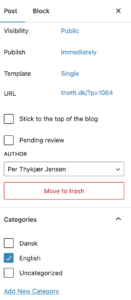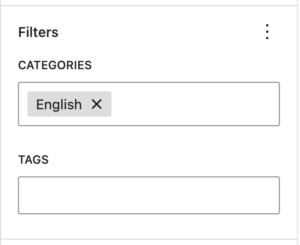Categories
You can give structure to a blog if you remember to add your Posts to one or more categories. Here you have to analyze your content. Which categories will be relevant in this case?
Categories can be anything from:
- Language (categories: English, Danish, Slovakian, German, Chinese)
- Topics (categories: fashion, kitesurfing, hiking)
To the right in the Post settings you can add any post to a category. If the category does not exist you can create it too:

In this case you can see a few language categories. This post is in the English category. You may want more categories than this.
Categories and the Menus
In the menus you can link to a category. The category is presented in the Archive template. So if you want to change the looks of the category page, that’s the template you’re looking for.
How to present a category in a post, page or template
You can present categories in several ways. Explore the options in Gutenberg.
Categories List
Will list all categories:
- Danske Tutorials (20)
- English Tutorials (22)
- FAQ (1)
- Multimediedesign (16)
- Portfolio (3)
- Programming (4)
- Tutorials (14)
- Uncategorized (3)
- Danske Tutorials
- English Tutorials
- FAQ
- Multimediedesign
- Portfolio
- Programming
- Tutorials
- Uncategorized
Categories
Will display the presnt category, as you see below here:
Query Loop
Add a Filter, and select Taxonomies. Click on the + and select categories. Now write the category you want to see. In this case the category below is “English”.
In this way you can filter the content by one or more categories:

Sample Query Loop
Category: English
-
Elementor Tutorials
-
New: Learn WordPress
-
AI and WordPress
Tags
Remember that you can add tags to a Post. Then you can filter by tags too – or even by a combination of tags and categories.
In this way you can add structure to a blog.

Leave a Reply